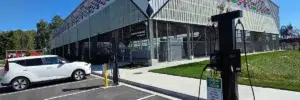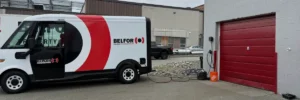Having trouble charging with your home Tesla charger?
Tesla’s Level 2 wall chargers provide fast, reliable charging for every model of Tesla electric vehicle. At TCA Electric, we have proudly installed hundreds of Tesla chargers over the years and we’re happy to share some of the insights we’ve learned along the way. Should you ever experience issues using your home charger to charge your Tesla, we encourage you to check out some of these troubleshooting tips—and if you can’t find a solution, don’t hesitate to contact the experts at TCA!
About Your Home Tesla Charger
The Tesla wall charger (also called the Wall Connector) provides Level 2 charging capabilities for your Tesla right from home. Tesla’s line of home charging solutions were among the very first to hit the market, and they’ve continued to innovate ever since. A Tesla wall charger can be installed inside or outdoors—whatever is more convenient for you! Faster than a Level 1 charger (such as the Tesla Mobile Connector), the Tesla Level 2 wall charger reliably offers charging speeds of up to ~80 km per hour of charging. While there is a Level 3 charger available, it is typically used in commercial applications and not available for home installation.
With a sleek yet durable design, and the continued popularity of Tesla’s electric vehicles, the latest Tesla wall charger continues to rank among the most popular home EV charging options.
Troubleshooting Common Problems
From poor connections to slow charging speeds, there are many problems you may encounter while charging with your Tesla wall charger. Some can be addressed yourself, through resetting, reconnecting, or a variety of other means. More persistent or severe issues will be cause to consult with your preferred EV charging electrician.
Charger Not Connecting to Wi-Fi
One of the most convenient features of Tesla’s latest EV chargers is their smart charging capabilities. Via Wi-Fi, you can change settings, schedule charges, and monitor usage all with a dedicated app—so it can be frustrating if your charger isn’t connected!
The first thing to know is that the device will only broadcast its Wi-Fi network for five minutes when it is first powered on. If you can’t find your device, those five minutes may have already elapsed. To broadcast the network again, either hold the button on the charging handle or turn the breaker connected to the charger off and back on again.
With the Wi-Fi network now broadcasting, use your preferred device to connect to the SSID Wi-Fi signal by scanning the QR code on your quickstart guide or by selecting the network and manually typing the WPA2 password. Once connected, navigate to http://192.168.92.1 and follow the onscreen commissioning steps. If problems persist, contact Tesla support.
Tesla Not Recognizing Charger or Not Charging
It can be frustrating when you plug your Tesla into its charger and no power is delivered. In this situation, there are a few troubleshooting options available to you.
The first is simply to reboot your Tesla vehicle. If the problem lies within your Tesla’s computing system, this will often resolve the issue. To reboot your Tesla, put your Tesla in Park and hold your foot on the brake. Then, press and hold both scroll wheel buttons located on your Tesla’s steering wheel. After 10 seconds, the center screen will begin rebooting. Continue to wait with your foot on the brake until the screen fully boots up once more, then attempt to charge your Tesla again.
If this doesn’t resolve the issue, the problem may lie with either your Tesla’s battery or your Tesla home charger. To narrow down these potential problems, first try to charge your Tesla at another location, such as one of Tesla’s many remote charging stations in Canada. If your Tesla charges there without a problem, the issue probably lies with your charger. Follow your charging device’s instructions to reset the charger, then attempt to charge again. If the issue persists, it may be time to contact one of the EV charging electricians at TCA.
A Flashing or Solid Red Light Is Being Displayed
You may already know that your home Tesla charger will flash a red light to communicate issues to you. What you may not know, however, is that the number of flashes it displays will tell you more about the issue your wall charger is facing.
These sequences may vary depending on the generation of charger that you own. For a complete list, check out the Troubleshooting section of your charger’s installation manual. If your problem is persistent, if you’re having difficulty identifying the sequence your wall charger is displaying, or if the sequence indicates a significant problem, contact Tesla support or the professional electricians here at TCA Electric.
Home Tesla Charger Not Charging Fast
The speed with which your Tesla charges depends on a variety of factors. To start with, each model of Tesla has its own maximum charge speed, with the Model 3 charging the fastest as of this writing. Another major factor is the maximum output of your circuit breaker. If you’re experiencing slow charging speeds, it may be because your circuit breaker’s maximum output falls short of your Tesla’s onboard charging capabilities. It may also be the case that your circuit breaker is operating near capacity, and thus it cannot dedicate sufficient power toward charging your Tesla. If your charging needs are not being met even with a Level 2 Tesla wall charger installed, the experts at TCA can help!
TCA Electric: Vancouver’s Home Tesla Charger Experts!
The TCA team has provided home EV charging solutions for many folks all throughout Vancouver. This includes expertise in every home Tesla charger, which offer some of the best charging speeds and convenient features available on the market. If you’re experiencing a problem with your home Tesla charger, the licensed and qualified electricians at TCA Electric are here to help! Whether it’s a hardware issue, faulty installation, or poor charging speeds, we can address any issues you may be experiencing. Contact us to schedule a professional consultation with one of our highly experienced EV charging electricians.
Featured image credit: Tesla



